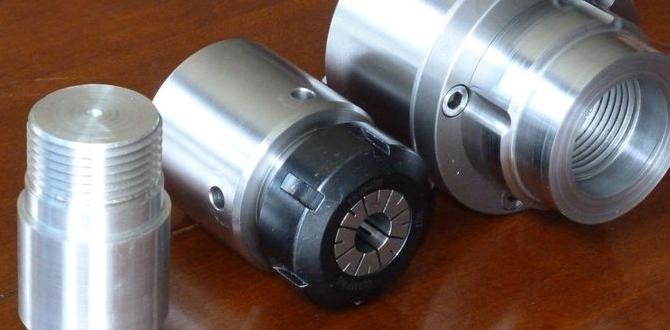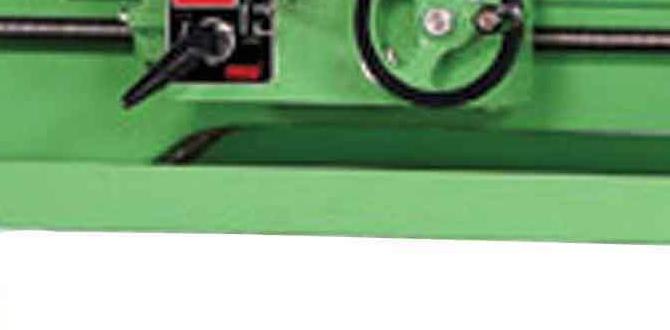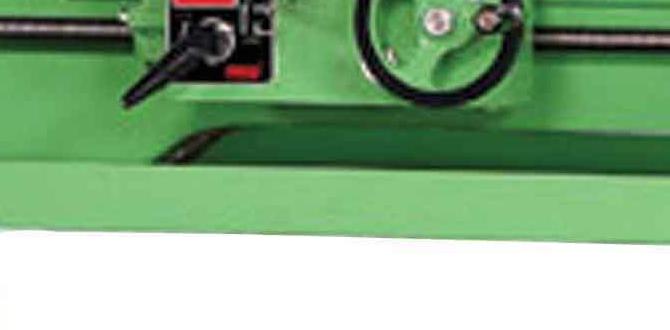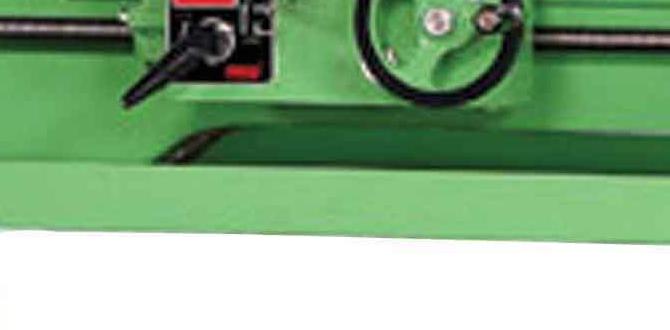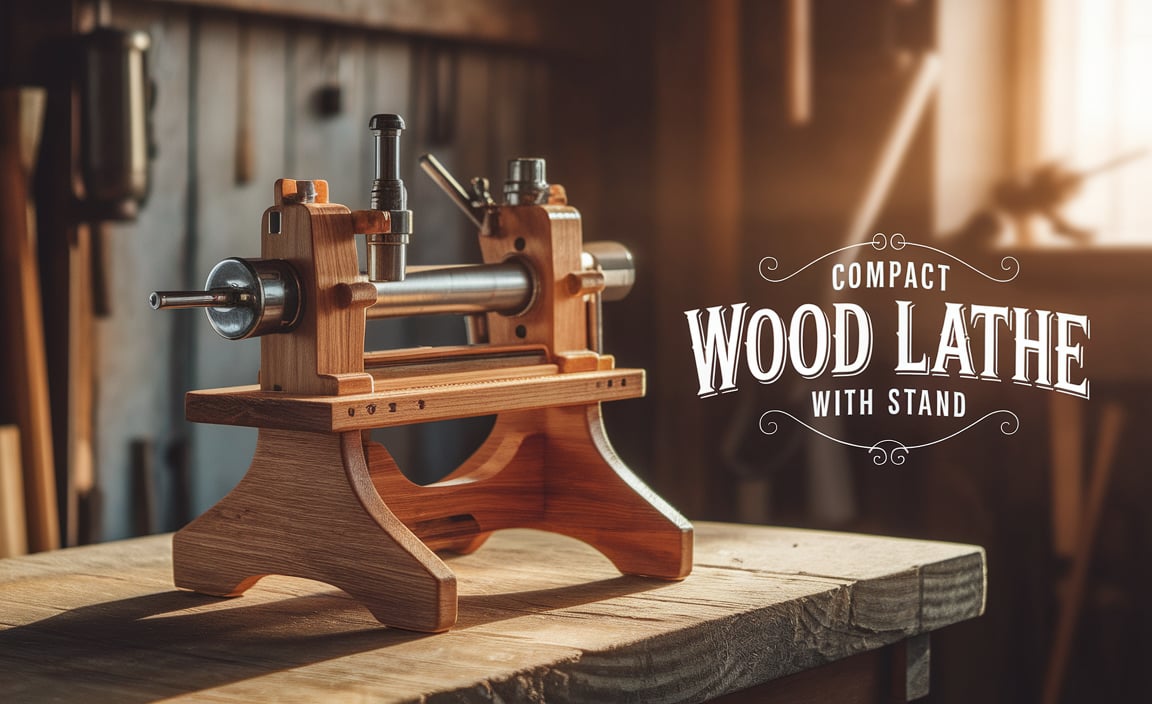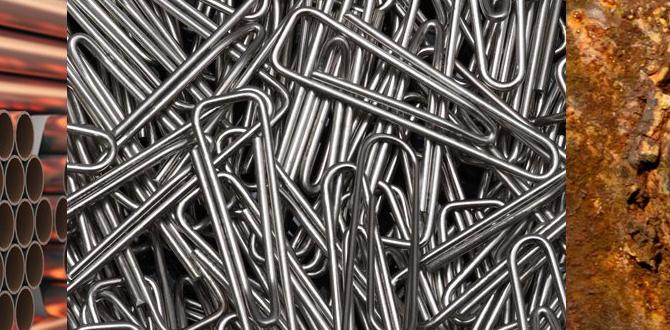Quick Summary: A radius tool for a lathe, also called a fillet tool or corner rounding tool, precisely shapes curved edges on workpieces. It’s essential for eliminating sharp corners, reducing stress, and creating a professional finish on metal or wood turning projects. Understanding its use leads to safer, more durable, and aesthetically pleasing results.
Welcome to Lathe Hub! Ever looked at a turned part with a beautiful, smooth curve on the edge and wondered how they achieved that? Often, the secret is a specialized tool: the radius tool for a lathe. These handy tools are designed to create perfect, consistent curves, often called fillets or rounds, on your workpieces.
Sharp corners can be weak points, prone to cracking or breaking under stress. They can also snag on things or just look unfinished. That’s where the radius tool shines! It gracefully transitions from one surface to another, smoothing out those harsh angles. It’s a simple concept, but mastering its use on your lathe can make a huge difference in the quality and safety of your projects.
At Lathe Hub, we believe in making machining accessible. We’ll guide you through what a radius tool is, why you’d want to use one, the different types available, and most importantly, how to set it up and use it safely and effectively on your lathe. Get ready to add a professional touch to your turned creations!
What is a Radius Tool for a Lathe?
A radius tool for a lathe is a cutting instrument used to create a curved surface, typically on the edge or corner of a rotating workpiece. Instead of leaving a sharp, 90-degree angle or a chamfer (a 45-degree bevel), a radius tool carves out a smooth, concave or convex curve. This curve is often referred to as a fillet or a round.
Think of it like smoothing out a sharp corner. On a metal workpiece, a sharp corner can be a stress riser, making it more likely to fail under load. A radius distributes stress more evenly, increasing the part’s strength and lifespan. In woodworking, a radius not only looks more appealing but also prevents splintering and provides a comfortable grip.
These tools come in various forms, but their core purpose remains the same: to impart a specific radius onto a material as it spins on the lathe. They are indispensable for creating parts that need to withstand stress, function smoothly, or simply have a more refined aesthetic.
Why Use a Radius Tool? The Key Benefits
Using a radius tool isn’t just about making things look pretty; it’s often about enhancing functionality and durability. Here are the primary reasons why a machinist or woodworker would reach for a radius tool:
- Increased Strength and Durability: As mentioned, sharp corners are weak points. Radii help to distribute stress concentration, making the part less prone to cracking or fatigue failure. This is critical in engineering applications where parts are subjected to mechanical loads. For guidance on material properties and stress, resources like the Materials Science and Engineering section at NDT Resource Center can be very informative.
- Improved Aesthetics: Smooth, rounded edges simply look more professional and appealing than sharp or abruptly cut corners. It’s a hallmark of well-made turned components in both metal and wood.
- Reduced Wear and Tear: In components that rub against other parts or are handled frequently, a radius can reduce friction and wear. It also prevents snagging.
- Easier Assembly: Sometimes, a slight radius on an edge can make it easier to insert a mating part, especially if tolerances are tight.
- Preventing Splintering (Woodworking): In woodturning, sharp edges can easily splinter or break off. A radius tool creates a clean, stable edge.
- Safety: Eliminating sharp edges reduces the risk of cuts or injuries during handling or use.
Types of Radius Tools for Lathes
Radius tools aren’t a one-size-fits-all solution. They come in several forms, each suited to different tasks, materials, and lathe types. Understanding these variations will help you choose the right tool for your project.
1. Standard Radius Turning Tools (HSS/Carbide)
These are the most common and versatile radius tools. They are essentially single-point cutting tools with a precisely ground concave cutting edge. They are typically made from High-Speed Steel (HSS) or are tipped with Tungsten Carbide for greater hardness and longevity, especially when working with harder metals.
- Design: They have a shank that fits into the lathe tool post. The cutting tip is ground to a specific radius (e.g., 1/8″, 1/4″, 1/2″). You can buy tools with a fixed radius or inserts that can be swapped out for different radii.
- Usage: Used for internal and external radii. For external radii, the tool is advanced into the rotating workpiece. For internal radii, it’s often used with a boring bar.
- Pros: Versatile, effective for various materials, can achieve precise radii.
- Cons: Requires proper tool setting, can chatter if not rigidly held or if feeds are too aggressive.
2. Radius Grooving Tools (Parting Tools with Radius)
These tools are primarily designed for cutting grooves or parting off material, but they have a rounded cutting edge on the nose. This allows you to simultaneously create a groove and add a small radius to the bottom or sides of the groove.
- Design: Resemble parting tools but with a radiused tip. They are often quite thin.
- Usage: Ideal for creating radiused grooves or when parting off a workpiece and wanting to leave a small radius where the tool cut through.
- Pros: Efficient for specific grooving tasks, can create very small radii.
- Cons: Limited to the radius ground on the tip, not as versatile as a dedicated radius tool for larger radii.
3. Ball End Mills (for CNC/Milling Lathes)
While not exclusively a “lathe tool” in the traditional sense, ball end mills used in CNC lathes or milling attachments are crucial for creating internal radii. These are end mills whose tip is a perfect hemisphere.
- Design: Standard end mill shank with a hemispherical cutting tip.
- Usage: Used in CNC machines or manual milling attachments on a lathe to profile and create internal pockets or fillets. They are good for creating a radius on a flat surface or inside a corner.
- Pros: Excellent for complex shapes and internal features, very precise.
- Cons: Requires a milling capability on the lathe (CNC or attachment), not for manual single-point turning.
4. Forming Tools (Specialized Dies/Cutters)
These are custom or semi-standard tools that are ground to a specific profile, which includes a radius. They can be used in a dovetail tool holder and are advanced into the workpiece to form a desired shape, including a radius.
- Design: Can be a solid piece of tool steel ground to shape or a carbide insert. They are often used in a special holder than allows them to rock into the workpiece as it spins.
- Usage: Best for repetitive tasks where the same radius is needed on many parts. They can create both convex and concave radii.
- Pros: Very fast for dedicated operations, can create complex profiles.
- Cons: Less versatile, often custom-made and expensive, require specific tooling setups.
5. Round Nose Scrapers (Woodturning)
In woodturning, a round nose scraper is a workhorse for creating concave surfaces and smoothing. While it can be used for fairing, it’s more of a shaping tool than a precise radius-generating tool like its metalworking counterparts.
- Design: A scraper with a rounded nose.
- Usage: Used to hollow out bowls, shape coves, and create smooth, concave surfaces. Can also be used to “round over” edges in wood.
- Pros: Excellent for smoothing and shaping wood, forgiving.
- Cons: Not precise enough for small, exact metal radii, it’s a scraping action, not a cutting one.
Setting Up Your Radius Tool for Lathe Use
Proper setup is crucial for achieving good results and preventing tool breakage. The process varies slightly depending on the type of radius tool and your lathe, but the core principles are the same.
1. Tool Holder and Tool Post
Ensure your tool post is in good condition and can securely hold the radius tool. For standard HSS or carbide radius tools, a standard three- or four-jaw chuck or a quick-change tool post can work. If using a forming tool, you might need a specialized holder.
2. Aligning the Tool
This is the most critical step. The cutting edge of the radius tool must be set dead center with the lathe’s spindle axis.
For External Radii:
- Mount your radius tool in the tool post so that the shank is parallel to the ways of the lathe.
- Using a height gauge or, more commonly, a small hex wrench or piece of stock slid between the tool bit and the workpiece (or center if no workpiece is mounted), adjust the height of the tool post or the tool itself until the cutting tip is at the same height as the tailstock center.
- To verify, place a small piece of paper between the tool tip and the workpiece’s center height. You should be able to slide it in and out without feeling resistance or getting it pinched.
For Internal Radii (using a radius grooving tool or specialized internal radius tool):
- The tool must be set dead center, just like for external work.
- When cutting internal radii, ensure the tool is rigid and the boring bar it’s in is also properly supported.
3. Tool Engagement Angle
For standard single-point radius tools, the tool should generally be set with no lead angle or back rake. It should be presented square to the workpiece. Some specialized radius tools might require a slight angle, but for beginners, square is usually the way to go.
4. Clearance
Ensure there is sufficient clearance between the body of the tool and the workpiece, especially as you feed into the part. You don’t want the non-cutting surfaces of the tool to rub. You might need to adjust the height slightly or use specialized holders to get this right.
Step-by-Step Guide: Using a Radius Tool on Your Lathe
Here’s a practical guide to cutting a radius on the corner of a workpiece using a standard single-point radius tool.
1. Prepare Your Workpiece
Ensure your workpiece is securely mounted in the lathe chuck and has been faced or turned to the correct diameter where the radius will begin.
2. Select the Correct Radius Tool
Choose a radius tool that matches the desired radius for your project. If you need a 1/4-inch radius, use a tool ground for a 1/4-inch radius.
3. Mount and Align the Tool
Mount the radius tool in the tool post. Carefully set the tool height to be exactly on center with the spindle axis, as described in the setup section above. This is paramount for a clean cut.
4. Set Your Cutting Speed and Feed Rate
Consult machining handbooks or online resources for recommended cutting speeds and feed rates for your material (e.g., aluminum, mild steel, brass, or wood). For beginners, starting a bit slower and using a moderate feed rate is wise.
- Speed: Revolutions per minute (RPM) of the spindle.
- Feed Rate: How fast the tool moves along the workpiece (could be manual or automated).
5. Make a Test Cut (Optional but Recommended)
If possible, make a light test cut on scrap material or a less critical area of your workpiece to verify the setup and cutting parameters. Check the radius produced and listen to the sound of the cut.
6. Engage the Tool for the Radius
With the spindle rotating at the correct speed, and if using power feed, set it to a moderate rate. Manually or via power feed, slowly advance the radius tool into the rotating workpiece. The cutting edge should smoothly engage the corner.
Important: For external corner radii, you are typically cutting from the side or end of the workpiece inward. The tool’s concave edge will “scoop out” the material to form the radius.
7. Completing the Radius
Feed the tool across the corner until the full radius is formed. You can often tell when you’re done by the sound of the chip formation or by observing the surface finish.
For a perfect radius, you may need to take multiple passes. Start with a shallow depth of cut (e.g., 0.010″ – 0.020″ for metal) and gradually increase it over several passes until you reach the final depth, or until the tool no longer cuts substantial material.
8. Finishing Pass
For the final pass, take a very light cut (a “cleanup pass”) at a slower feed rate to achieve a smooth, polished surface finish.
9. Retract and Inspect
Once the radius is complete, retract the tool from the workpiece. Turn off the spindle and inspect the radius. Check its consistency and finish. If necessary, you can make another light pass or use abrasive materials for final polishing.
Radius Tool Considerations for Different Materials
The material you are working with significantly influences your choice of radius tool and how you use it.
Metals (Steel, Aluminum, Brass)
Tooling: Carbide-tipped radius tools are preferred for their hardness and heat resistance. HSS can be used for softer metals like aluminum and brass but will wear faster.
Speeds & Feeds: Generally lower RPMs and controlled feed rates are needed.
Lubrication: Cutting fluid or coolant is essential to keep the tool cool, prolong its life, and improve surface finish.
Chip Control: Metal chips can be sharp and hot. Ensure they are being cleared away effectively.
Plastics
Tooling: Carbide or HSS tools work well. Sharp tools are essential to prevent melting or “gumming up.
Speeds & Feeds: Often higher speeds with lighter cuts can produce a good finish.
Lubrication: Sometimes air blast or a specific plastic cutting lubricant is used.
Chip Formation: Plastics can produce stringy or flaky chips.
Wood
Tooling: HSS is the standard. For shaping, round nose scrapers are common. For precise, repeatable radii on multiple parts, dedicated forming tools or even CNC bits can be used.
Speeds & Feeds: Generally higher RPMs than metal. Feed rates depend on the wood’s hardness and the cut depth. Avoid “fanning” the tool (taking large cuts with a scraping action) which can cause tear-out.
Lubrication: Not typically used for cutting, but a finishing wax or polish can enhance the final look.
Chip Formation: Wood chips and dust. Ensure good dust collection.
Common Problems and How to Fix Them
Even with the best intentions, you might run into issues when using a radius tool. Here are a few common ones and how to address them:
Problem: Tool Chatters or Vibrates
Cause: Tool is not sharp, tool post is loose, workpiece is not clamped securely, depth of cut is too large, tool is set too high or low, or the tool bit is too long and flexible.
Solution:
Ensure your tool is sharp.
Tighten the tool post and ensure the workpiece is rigid.
Take lighter cuts, especially on the first pass.
Re-check your tool height alignment – it must be precisely on center.
If using HSS, use a shorter bit and support it firmly.
Problem: Inconsistent or Uneven Radius
Cause: Tool not set on center, inconsistent feed rate, workpiece runout, material inconsistency.
Solution:
Double-check tool height alignment.
Maintain a steady, consistent feed rate, especially on the finishing pass.
Ensure your workpiece is properly trued up on the lathe.
If working with wood, try a slower speed to avoid tear-out.
Problem: Rough Surface Finish
Cause: Dull tool, feed rate too fast for the RPM, incorrect cutting fluid, taking interrupted cuts.
Solution:
Sharpen or replace the cutting edge.
Slow down the feed rate or increase RPMs slightly for the finishing pass.
Use an appropriate cutting fluid for metal.
Try to make a continuous cut in one pass for the finish.
Problem: Tool Digs In or Snags
Cause: Tool is too sharp with no relief angle (less

